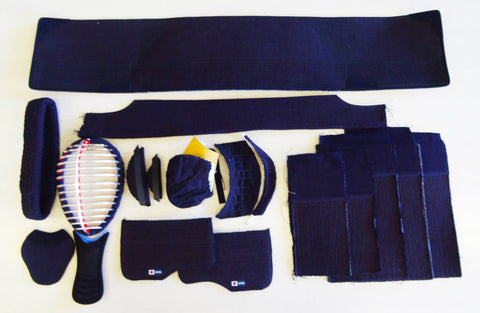Bogu Material Information

Orizashi



Orizashi Futon are covered with a thick layer of cotton, similar to the material used for the Kendogi. This is cheaper than using genuine leather, and has the advantage of being flexible and quick-drying. Therefore, Orizashi is well suited for hot climates. It is not as durable as leather, however, and it does not offer the same prestige as genuine deerskin. Orizashi Bogu is, however, one of the most popular options, and is a great way to cut costs on a high-quality Bogu set.
Synthetic Leather (Clarino Leather)

Synthetic leathers such as Clarino leather have been used for some time now as a substitute for genuine deerskin. In many cases, modern synthetic leather has become almost indistinguishable from real deerskin in terms of appearance when new, and are much cheaper to produce. Unfortunately, synthetic leather does have its downsides.
Synthetic leathers do not hold Aizome indigo dye the same way that genuine deerskin does, and over time, their color changes differently. Thus it does not produce the well known ‘faded blue’ look that Kendo practitioners have come to love. Further, although modern synthetic leathers have improved a great deal since their introduction into Bogu construction, they do tend to become "fuzzy" over time, and still do not quite compete with the outstanding durability offered by genuine deerskin. That being said, however, modern synthetic leathers allow us to create fantastic Bogu sets at reasonable prices – making quality affordable, to practitioners of all levels.
Gyukawa (Cow Leather)
Cow leather has been used as a substitute for deerskin for some time, and in general offers a very similar appearance. However, its popularity in Japan has decreased greatly in recent years. Although cow leather offers excellent durability, it does not react well to moisture, becoming stiff when drying out – making cow leather Bogu sets feel somewhat cumbersome. Further, it does not take to the dye as well as deerskin, making it turn somewhat grey, as oppose to faded blue, over time.
Konkawa (Genuine Indigo-dyed Deerskin)



Ever since the early days of Bogu construction, genuine Japanese deerskin has been favored for its flexibility and durability for reinforcing the Futon. Deerskin reacts well to moisture, remaining supple and flexible after drying, and it also takes the genuine Aizome (indigo-dye) perfectly – allowing it to fade naturally over time. Further, of all the materials used in the construction of Kendo Bogu, deerskin provides the best durability, helping the Bogu last for decades of frequent use. Unfortunately, the biggest downside of Konkawa material is its high price. Furthermore, although it is more durable than Orizashi, it does not dry as quickly, so it is not necessarily the best for consecutive use, particularly in humid environments.
